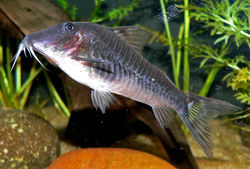Fish Guide
Corydoras
|
From Wikipedia the free encyclopedia, by MultiMedia |
| Corydoras | ||||||||||||
|---|---|---|---|---|---|---|---|---|---|---|---|---|

Corydoras semiaquilus
|
||||||||||||
| Scientific classification | ||||||||||||
|
||||||||||||
|
Corydoras geoffroy Lacepède, 1803 |
||||||||||||
|
Corydoras acutus (Blacktop corydoras) Corydoras adolfoi (Adolf's catfish) Corydoras aeneus (Bronze corydoras) Corydoras ambiacus (Spotted corydoras) Corydoras atropersonatus Corydoras axelrodi (Pink corydoras) Corydoras bondi (Blackstripe corydoras) Corydoras caudimaculatus (Tailspot corydoras) Corydoras cochui (Barredtail corydoras) Corydoras elegans (Elegant corydoras) Corydoras ehrhardti Corydoras evelynae Corydoras geoffroy Corydoras guapore (Guapore corydoras) Corydoras habrosus (Salt and petter catfish) Corydoras hastatus (Dwarf corydoras) Corydoras haraldschultzi (Mosaic corydoras) Corydoras latus Corydoras leucomelas (False spotted catfish) Corydoras loxozonus Corydoras macropterus (Sailfin corydoras) Corydoras melanotaenia (Green gold catfish) Corydoras melanistius (Bluespotted corydoras) Corydoras melini (Bandit corydoras) Corydoras metae (Masked corydoras) Corydoras nanus Corydoras narcissus Corydoras nattereri (Blue corydoras) Corydoras ornatus Corydoras osteocarus Corydoras paleatus (Peppered cory) Corydoras pastazensis (Pastaza corydoras) Corydoras panda (Panda corydoras) Corydoras polystictus Corydoras prionotos Corydoras pygmaeus (Pygmy corydoras) Corydoras reticulatus (Reticulated corydoras) Corydoras schwartzi (Schwartz's catfish) Corydoras semiaquilus Corydoras septentrionalis Corydoras simulatus Corydoras sodalis (False network catfish) Corydoras sterbai(Sterba's cory) Corydoras sychri (Sychr's catfish) Corydoras trilineatus (Threestripe corydoras) Corydoras undulatus Corydoras xinguensis (Xingu corydoras) |
Members of the South American Corydoras genus are freshwater temperate and tropical catfish in the armored catfish family, and are commonly referred to as cory catfish, cory cats, or simply corys. The type species for this genus is Corydoras geoffroy. The name Corydoras is derived from the Greek kory (helmet) and doras (skin).
Corydoras is a very large genus with over 180 described species. In addition, many variants exist. Several hundred Corydoras species are not yet classified, but kept by aquarists. These species are given C-Numbers, originally devised by Hans-Georg Evers for the German fishkeeping magazine DATZ in 1993. As of 2006, are 153 C-numbers assigned, of which 32 have subsequently been assigned appropriate scientific names.
Corydoras are native to slow-moving and almost still (but seldom stagnant) streams and small rivers of South America where the water is shallow and very clear. The preferred bottom seems to be sand or sand mixed with mud, sometimes covered with detritus or dead leaves. The banks and sides of the streams are covered with a dense growth of plants, and this is where the corys are found. They inhabit a wide variety of water types but tend toward soft, neutral to slightly acidic or slightly alkaline pH and 5-10 degrees of hardness. They can tolerate only a small amount of salt (some species tolerate none at all) and do not inhabit environments with tidal influences. Many species are found in schools or aggregations of hundreds or even thousands of individuals, usually of a single species, but occasionally with other species mixed in.
Their main food is bottom-dwelling insects and insect larvae and various worms, as well as some vegetable matter. Although no corys are piscivorous, they will eat flesh from dead fishes. Their feeding method is to search the bottom with their sensory barbels and suck up food items with their mouth, often burying their snout up to their eyes, one of the reasons a soft sand substrate is preferable.
In the aquarium
Corys are popular aquarium fish and typically measure around four to seven centimetres in length. They are well suited to tropical freshwater community aquariums, as they get along well with other species and are not at all aggressive. Corys are shy fish and it is recommended to keep them in groups of at least six as most species seem to form shoals in the aquaria (e.g. Paxton 1997). Corys are mostly bottom feeders, so they should be offered flake foods (which do sink), sinking pellets, and supplements of live and frozen foods, but care should be taken to prevent all the food from being eaten by the faster-moving fish at the higher levels of the tank.
Most corys prefer soft, acidic water. However, they can tolerate a wide range of water conditions. They do not do well in fish tanks with high nitrate levels. This ion leads to the infection of the barbels, which will shorten and become useless. The barbels may also be affected by constant contact with a sharp substrate. These are easy fish to keep, being peaceful, small, hardy, active, and entertaining. Occasionally they will dart to the surface, sticking their snout above the water for an instant, appearing to take a "breath" of fresh air. This behavior is perfectly normal and is not an indication that anything is wrong with the fish.
Where investigated Corydoras sp. have been shown to be diurnal and crepuscular rather than nocturnal and activity can even peak at twilight (Paxton 1997). Corydoras are very good choices for a community aquarium, and are widely kept throughout the world. Their longevity in the aquarium is noteworthy; C. aeneus is said to have lived 27 years in captivity and 20 years is not too uncommon.
External links
References
- "Corydoras". FishBase. Ed. Ranier Froese and Daniel Pauly. March 2006 version. N.p.: FishBase, 2006.
- Evers, Hans-Georg. A system called “C-Numbers” (english). Retrieved on 2006-06-08.
- Burgess, W. E. (1987). A Complete Introduction to Corydoras and Related Catfishes. Neptune City, NJ: T.F.H. Publications. ISBN 0-86622-264-2.
- Paxton, CGM (1997) Shoaling and activity levels in Corydoras catfish (Siluriformes: Callichthyidae) Journal of Fish Biology 51, 496-502.
Fish Guide, made by MultiMedia | Free content and software
This guide is licensed under the GNU Free Documentation License. It uses material from the Wikipedia.